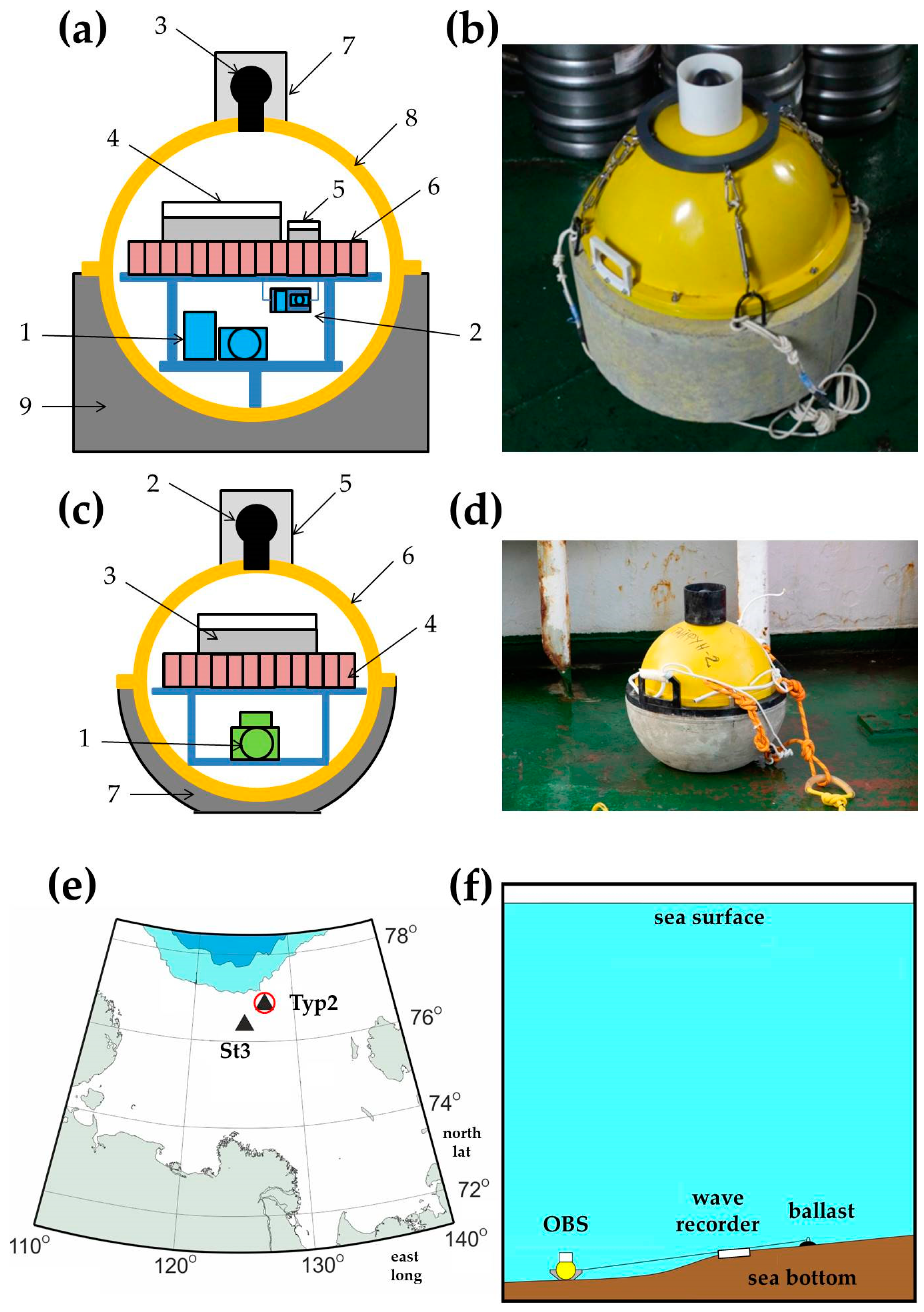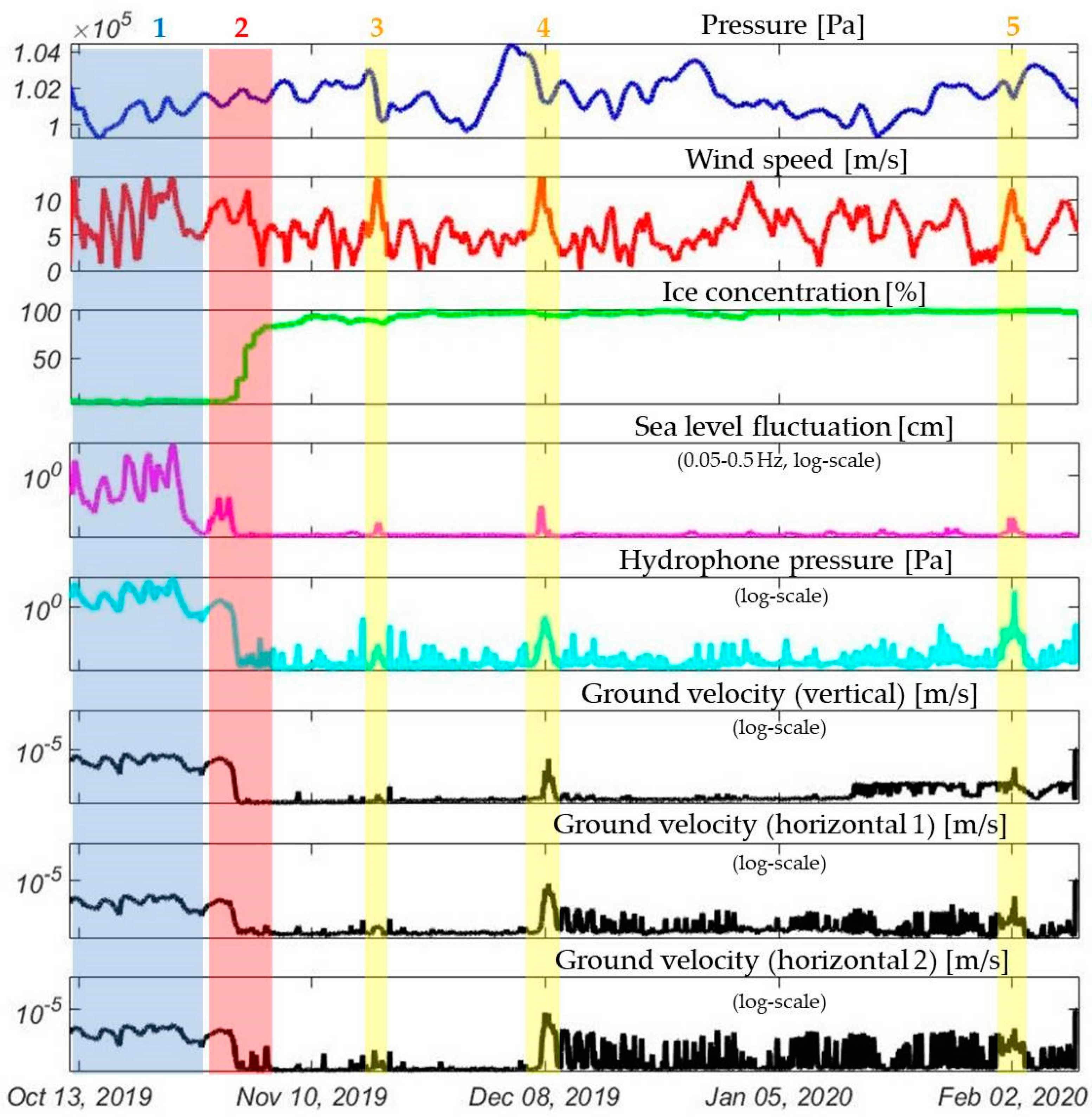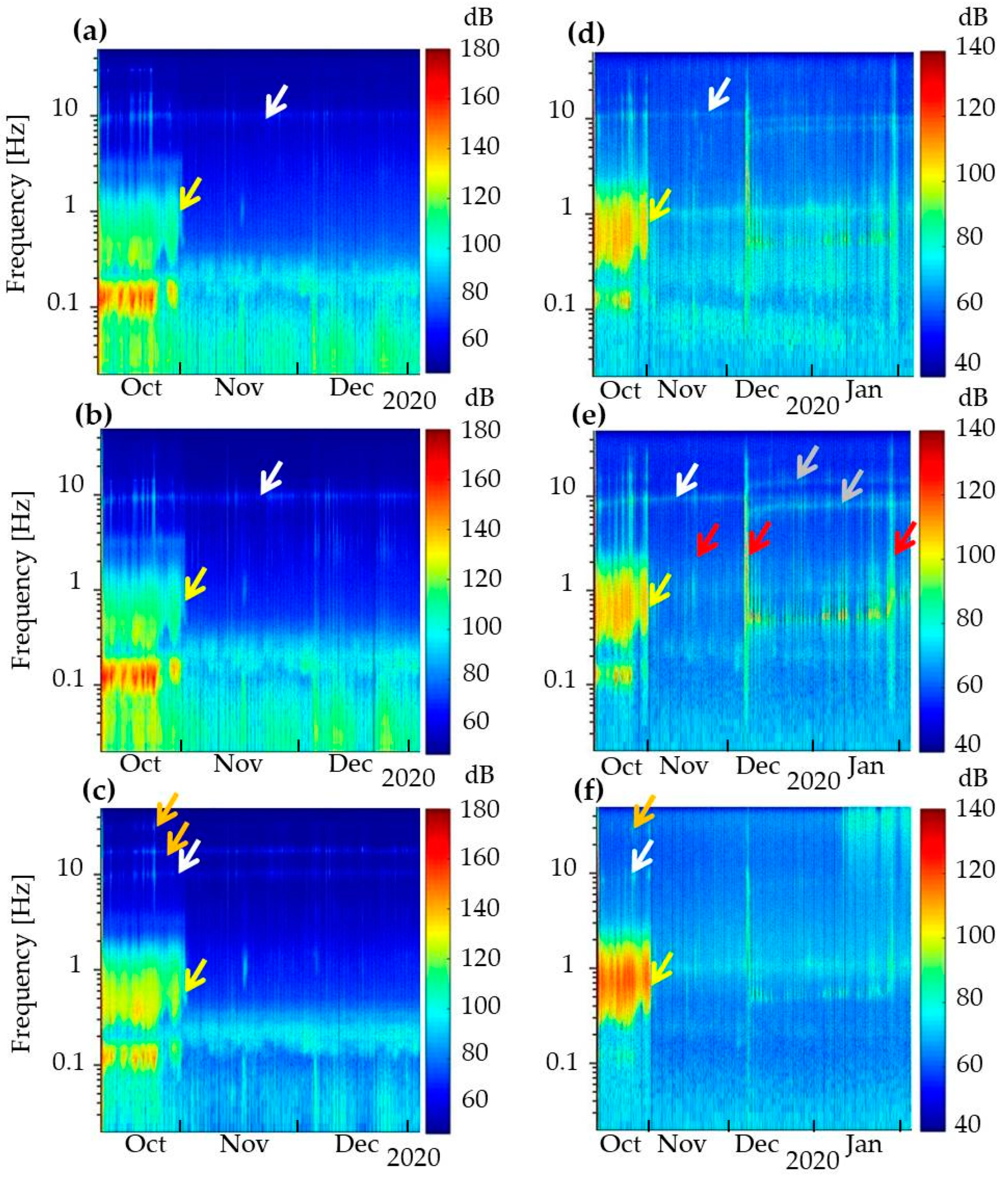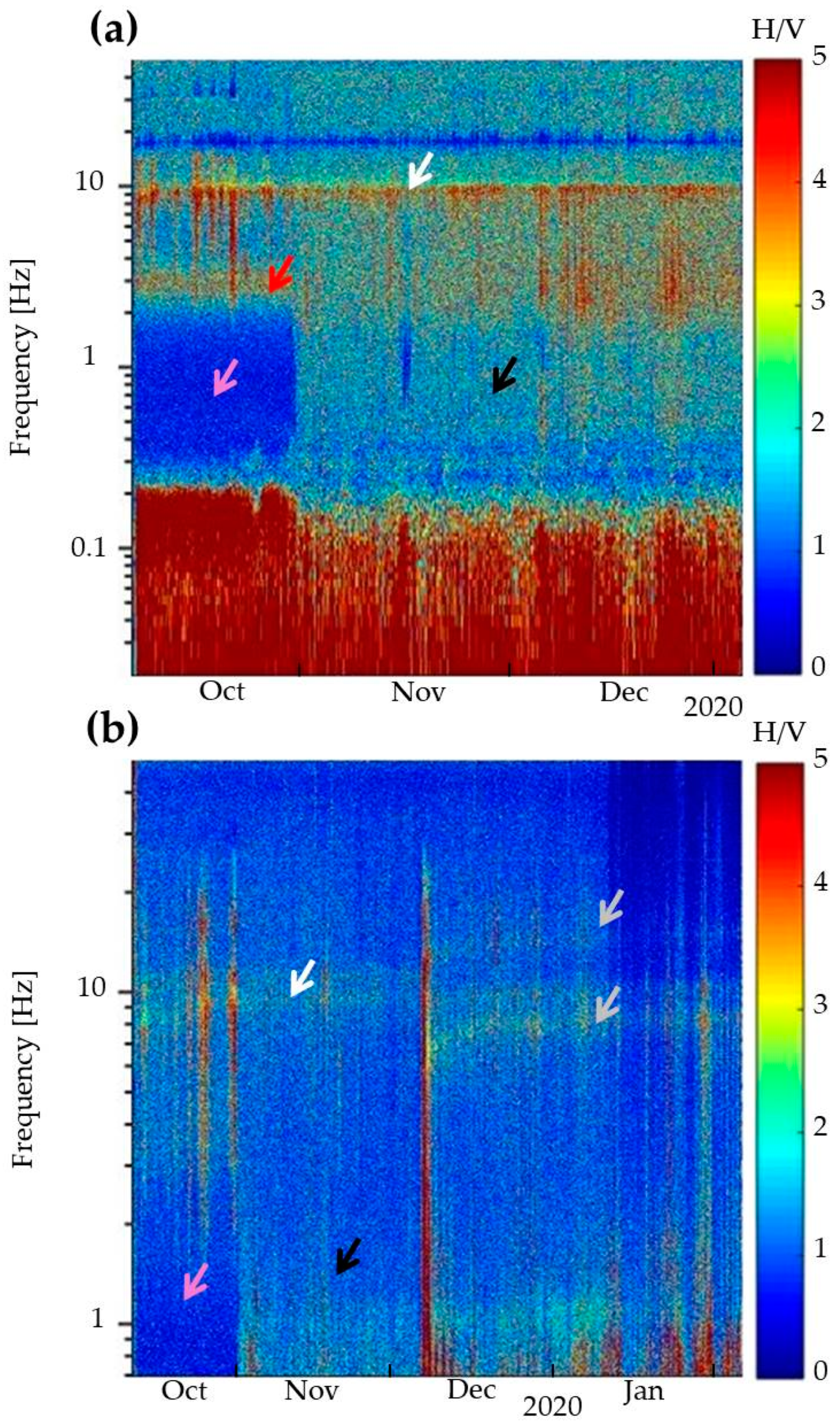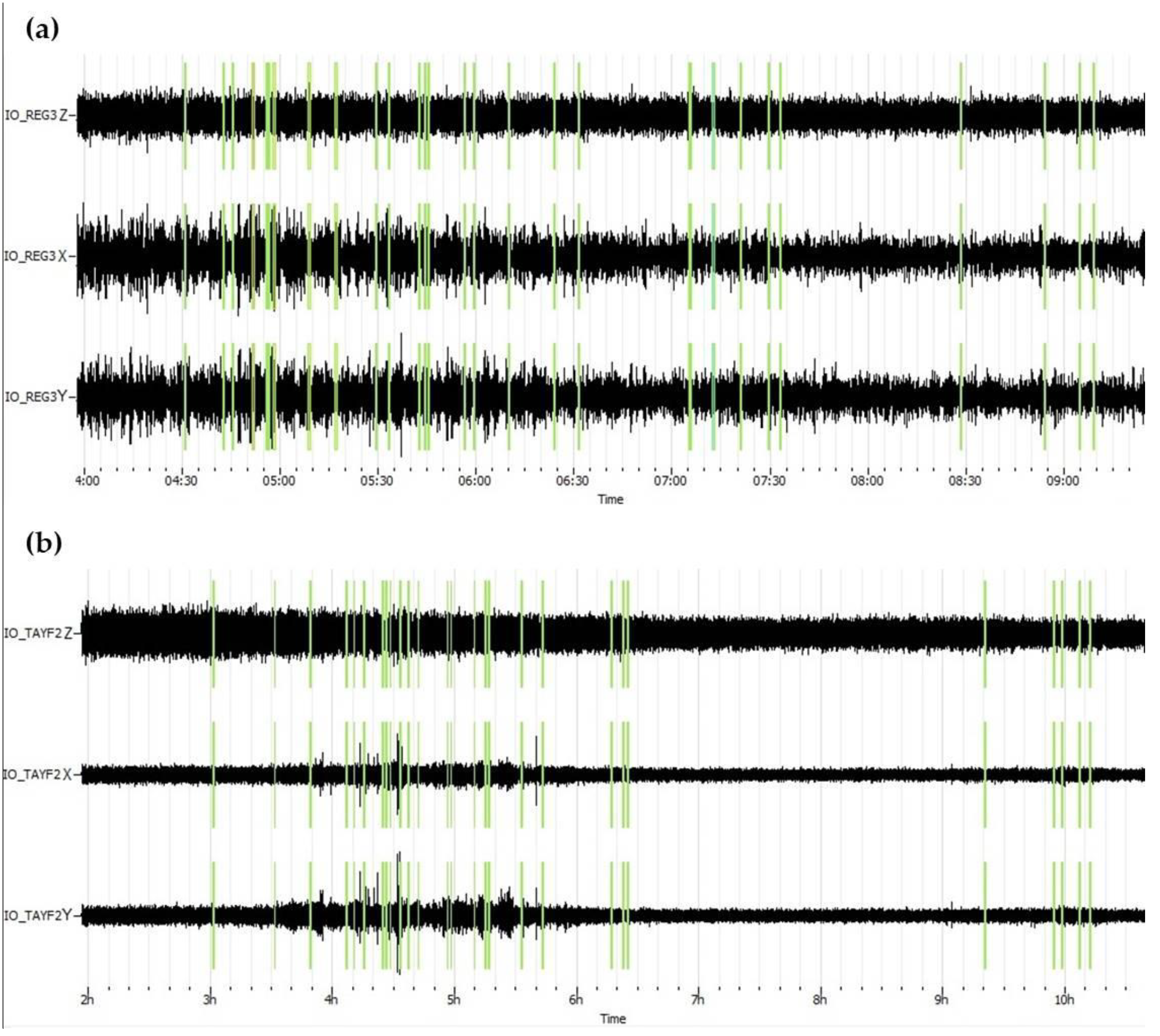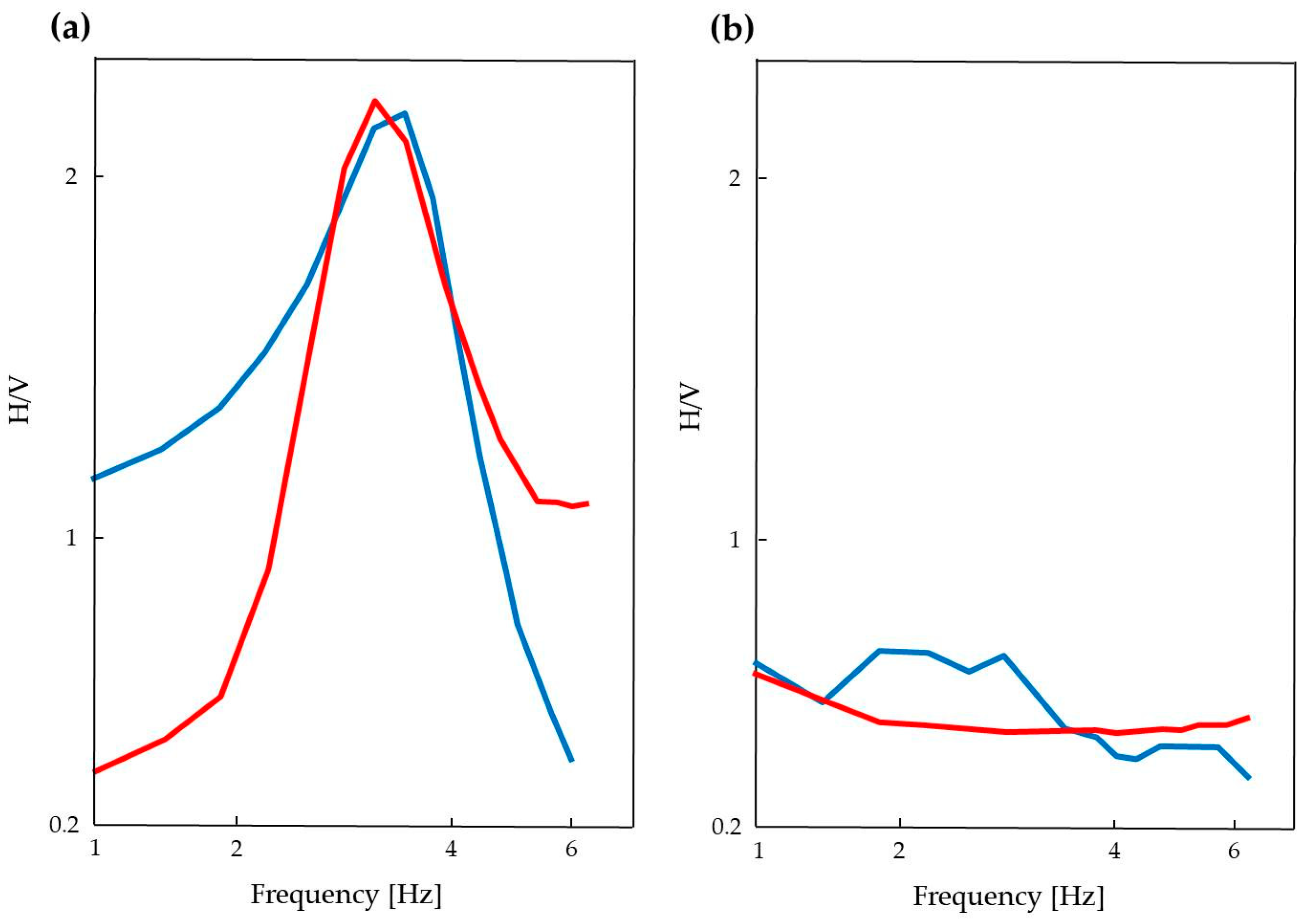1. Introduction
The horizontal-to-vertical spectral ratio (HVSR) method, also known as H/V, has become a standard and widespread observational method of soil amplification and fundamental frequency estimations due to its effectiveness, environmental friendliness, relative simplicity and low cost [
1,
2,
3,
4]. Since the first works [
5,
6], many scientific papers have been dedicated to HVSR modeling and inversion problems. However, there is an extreme lack of studies on the application of this method in marine conditions, i.e., using records from ocean-bottom seismographs (OBS).
In this article, we have tried to develop an understanding of this method as applied to the marine environment. To achieve this objective, we used long-term OBS records obtained in the Laptev Sea, which is one of the most interesting regions from a seismotectonic point of view. This is especially true for the northern part of the Laptev Sea, the area of the outer shelf and the continental slope, where the Gakkel spreading ridge junctions with the shelf structures. In this area, many also assume the existence of a large strike-slip fault zone [
7,
8,
9,
10].
The presence of permafrost is widespread on the shelf of the Laptev Sea [
11,
12,
13]. At the same time, in the central part of the outer shelf of the Laptev Sea, there is a zone of sparse permafrost and open taliks, which is confirmed by both the modeling results [
12] and the data from offshore geophysical surveys [
14,
15].
In the Laptev Sea, a large number of methane outflows from the seabed have been found, especially on the mentioned central part of the outer shelf [
16,
17,
18]. Recent studies show a deep thermogenic origin of the escaping gas on the outer shelf of the Laptev Sea [
19]. Methane of deep origin can come from great depths along faults and reach the seafloor through wide taliks.
Until now, the application of the HVSR technique for the determination of the thickness of unfrozen sediments above the submarine permafrost has been very limited [
20,
21]. Many questions regarding the application of this method in marine shelf conditions, especially in the Arctic, and in particular in the presence of sea ice cover, remain open. Thus, the objective of the paper is to describe the features of applying the HVSR modeling and inversion techniques to seismic records obtained by OBSs on the outer shelf of the Laptev Sea, and to estimate the depth of the main shear wave impedance contrast, which can be associated with the transition from ice-free sediments to ice-bonded permafrost. In this case, the primary task is to describe the features of the recorded ambient seismic noise, which must be taken into account during HVSR modeling and interpretation. The processing of the ambient seismic noise recorded in the Laptev Sea, as well as the wave recorder data and the ERA5 and EUMETSAT reanalysis data, allowed the study of the dependency of seafloor seismic noise on the presence of sea ice cover, as well as sea waves in various frequency bands and weather conditions, wind speed in particular.
5. Discussion
A description of seafloor seismic noise features is necessary for HVSR modeling and interpretation. Only by taking into account the characteristics of seismic noise is it possible to adequately select a frequency confidence range for further searching for resonant peaks associated with a contrasting reflective boundary under the seabed surface. In the present study, such a confidence frequency range was between 1 and 6 Hz. It was this frequency range that was used for the HVSR inversion (
Figure 11). The level of seismic noise at frequencies below 1 Hz at the studied shelf sites strongly depended on the intensity of the wind waves of the sea, and therefore on the wind speed and the presence of ice cover. The maximum level of seismic noise during the period of time when the sea was ice-free was in the frequency ranges 0.1–0.2 Hz and 0.3–1.5 Hz (
Figure 2 and
Figure 3), related to primary and secondary microseisms, which are recorded everywhere and are the result of processes related to sea gravity waves and atmospheric pressure [
41,
44,
45]. When the sea was covered with ice, this low-frequency seismic noise level decreased, but nevertheless remained, periodically increasing at certain intervals under the influence of an increase in wind speed and a drop in atmospheric pressure (
Figure 2 and
Figure 3). The wind effect on seismic noise has also been noticed for on-land seismographs. It is present in the low frequency range and is caused by natural wind directly blowing on the sensor [
46,
47,
48,
49].
The high-frequency seismic noise at frequencies above 6 Hz with the clear maximum at 9–10 Hz is highly distorted by the parasitic oscillations in the system “station–ballast–soft sediments” (coupling effect), which is usually observed in the high-frequency range of 5–10 Hz [
41]. While the signal amplification at 10 Hz was present all the time at any wind strength, the additional parasitic oscillations maxima appear at 18 and 30 Hz with an increase in wind speed (
Figure 4).
There is a clear correlation between sea level fluctuation in the 30 s–5 min spectral periods range related to infragravity sea waves [
40,
50,
51], ambient seismic noise and wind speed, as seen in
Figure 5. This pattern may be due to the supposed similarity of the mechanisms behind the generation of the ocean infragravity waves and seismic noise [
51]. Long-period horizontal noise levels for sensors on the seafloor are higher than vertical noise levels [
41], as also seen in
Figure 2. Interestingly, sea level fluctuations in the spectral range related to infragravity waves correspond to fluctuations in wind speed better than ordinary gravity waves. Perhaps this is due to the fact that the infragravity waves have a larger length and are more stable in time. The ordinary wind-generated gravity waves and swell are less stable, since they have a shorter period (5–8 s), while the infragravity waves are more inert. This is important, especially since the reanalysis data was measured hourly. Separately, it is necessary to note the excellent agreement between the reanalysis data and the observational data.
Long-period seismic noise with spectral periods larger than 30 s is associated with both infragravity waves and seafloor currents [
41]. Current-induced tilt noise is caused by seafloor currents flowing past the instrument and in eddies spun off the back of the instrument [
52,
53,
54]. The current noise at deep seafloor sites is usually orders of magnitude larger than infragravity wave noise [
41], but at shallow depths this could be the reverse, especially in view of the fact that, according to the data obtained, no obvious dependence of seismic noise on tides was revealed, i.e., characteristic periodicity, while
Figure 5 demonstrates significant correlation between the amplitudes of infragravity waves and seafloor seismic noise. Thus, it can be assumed that at the considered sites, the effect of infragravity waves on long-period seismic noise is predominant.
Even though infragravity wave amplitudes decrease with increasing ocean depth, the signal remains significant to depths of many kilometers below the seabed depending on the frequency and the elastic parameters as a function of depth [
41]. At shallow depths, gravity and infragravity waves can drive motions directly, tilting the instrument [
41,
55,
56]. However, it is difficult to estimate the relative contribution of the direct tilting of the instrument to the total level of recorded long-period noise.
The HVSR time-frequency plots presented in
Figure 6 show the reduced level of HVSR in the low-frequency band of 0.2–2 Hz during the period of time when the sea was free of ice. This makes the high-frequency peaks above 2 Hz more pronounced. This can be explained by the fact that an increased level of seismic noise in the frequency range 0.2–2 Hz, caused by the wind waves of the sea, is observed both on the horizontal and vertical components of seismometers. Therefore, the ratios of the smoothed spectral curves have low values in this frequency range. In the same time period, when there was ice on the sea and the seismic noise caused by the wind waves was reduced, the HVSR curve becomes flatter over the entire time and frequency range. The signal maximum at 9 Hz, which corresponds to the coupling effect, is also well pronounced on the HVSR curves.
HVSR can also be used to estimate the ellipticity of the fundamental mode Rayleigh wave, which has the advantage of defining the total depth of the soft sediments [
57]. The principal problem of retrieving ellipticity from HVSR spectral ratios is to correct for the energy of body and Love waves present in the ambient vibration recordings [
58,
59]. This could be provided by classical polarization analysis in the frequency domain or by identifying P-SV wavelets along the signal and computing the spectral ratio from these wavelets only [
59]. In the framework of this work, these methods were not considered.
Based on the characteristics of the region where the OBSs were deployed, we assumed that the sub-bottom reflecting boundary, most likely, would be the upper surface of the permafrost, and the layer of soft sediments above it would consist of silty soils. Since the exact values of soil densities and seismic wave velocities for the study area are unknown, their values were taken from reference materials. All this together leads to a significant uncertainty in the assessment of the depth of the reflecting boundary and the results of the HVSR inversion. In the case of the Typ2 site, the inversion is further complicated by the absence of a resonant peak in a representative frequency range of the HVSR curve. Therefore, the results of the inversion for the Type2 site should be treated as very approximate. It should also be noted that due to the fact that the inversion is based on the Monte Carlo method, the result obtained can be considered as only one of the possible solutions.
Many papers present formulas that correlate cover thickness with the frequency of the HVSR main peak [
49,
60,
61,
62,
63,
64]. All of them have the following general form:
Table 11 shows the values of the parameters
a and
b obtained from different sources, along with corresponding values of calculated
d for the St3 site. It can be seen that the thickness values vary significantly from 11.7 to 28.9 m, which is quite understandable, because these empirical formulas were obtained in different regions and for different parameters of soils. In the present study, a thickness value of 17.7 m was obtained. The formulas from [
61,
62] give the closest estimate.
